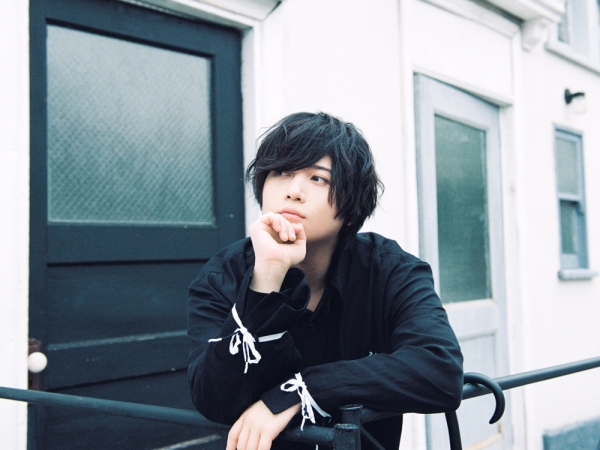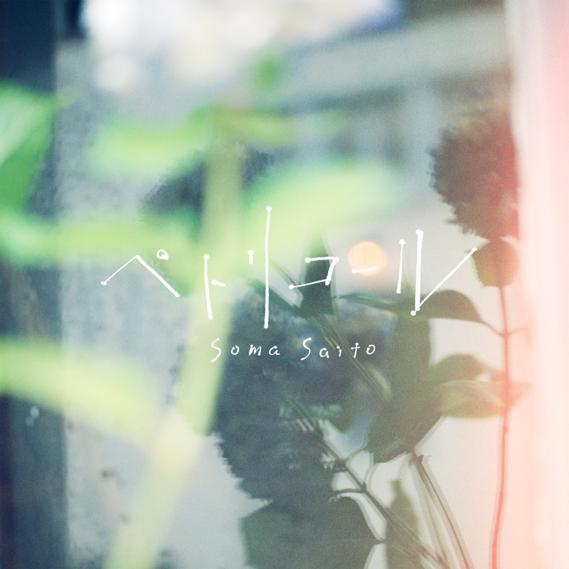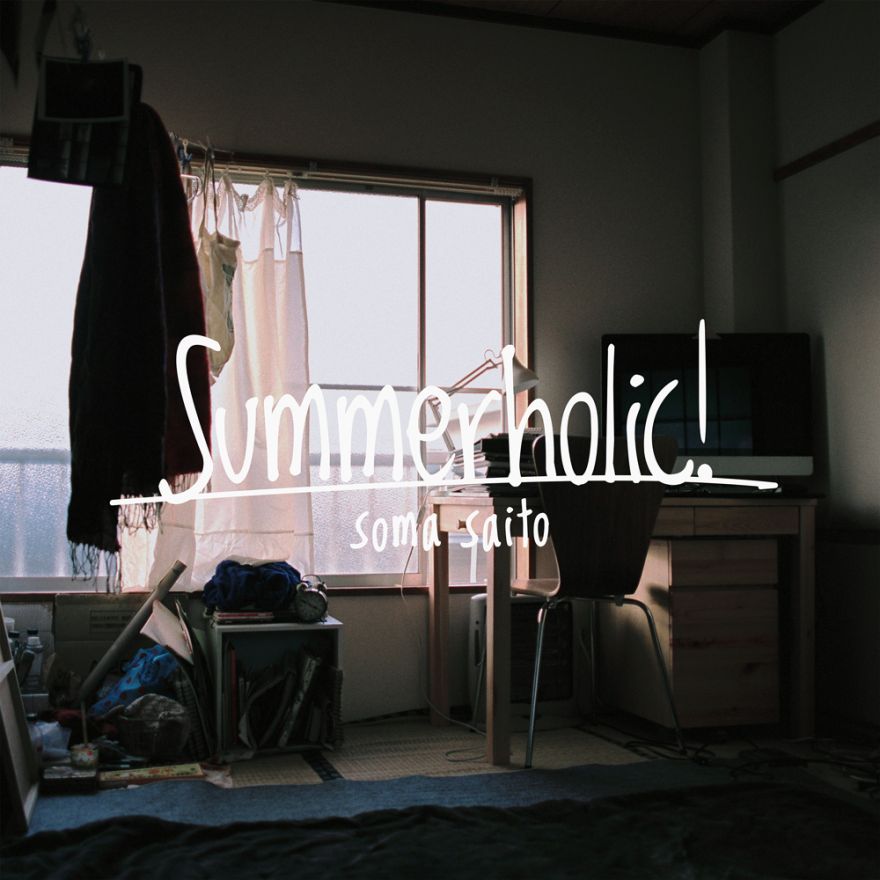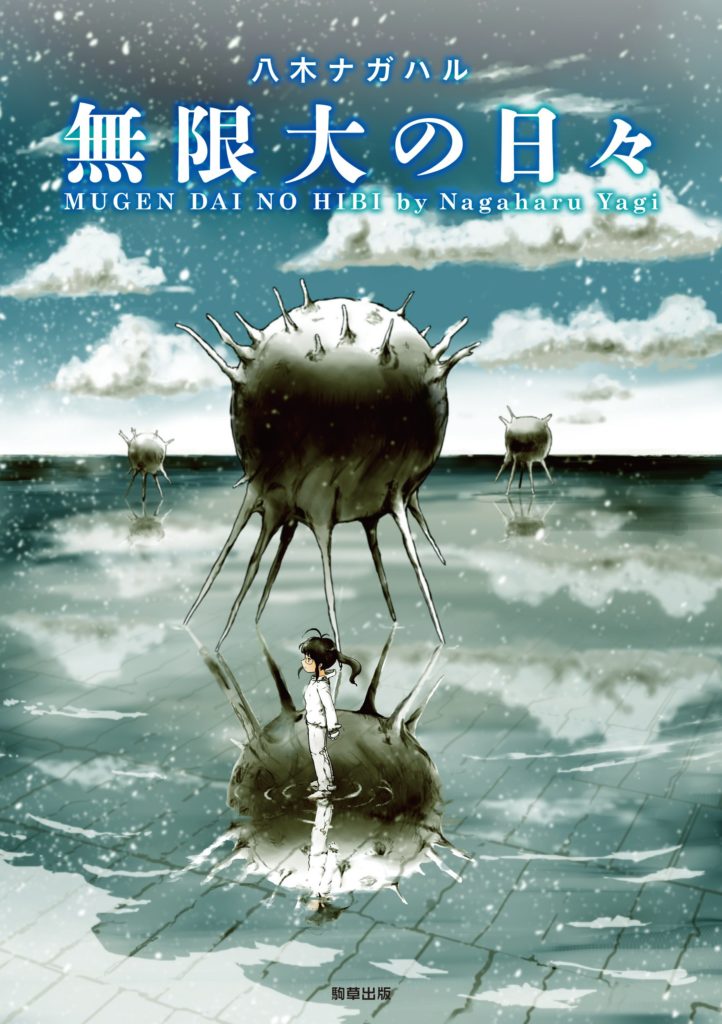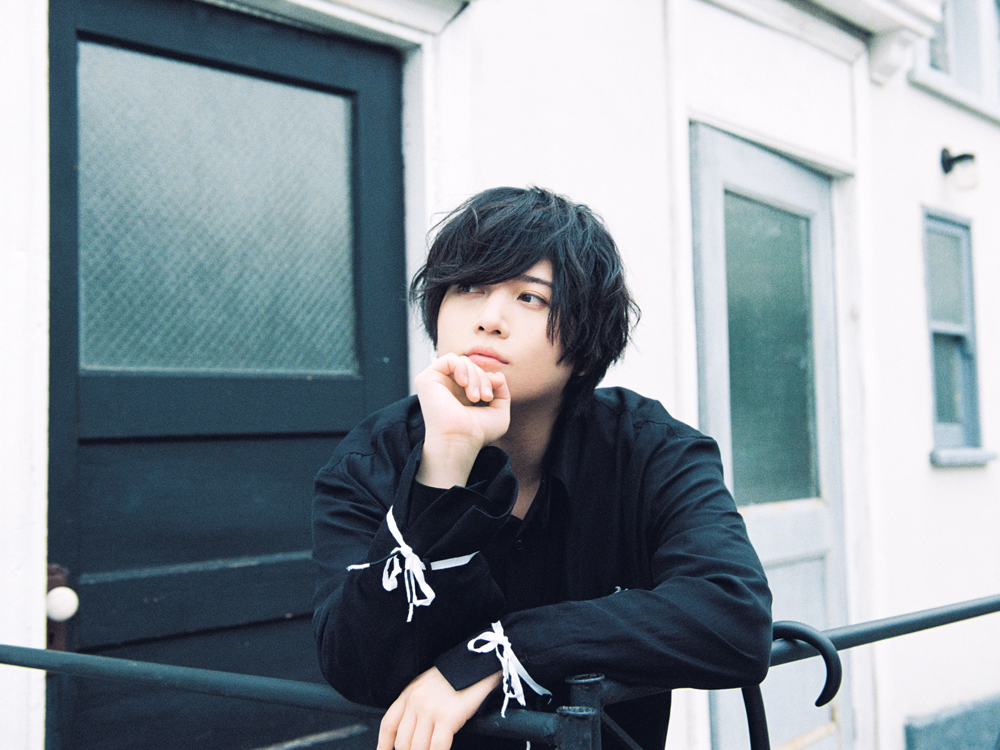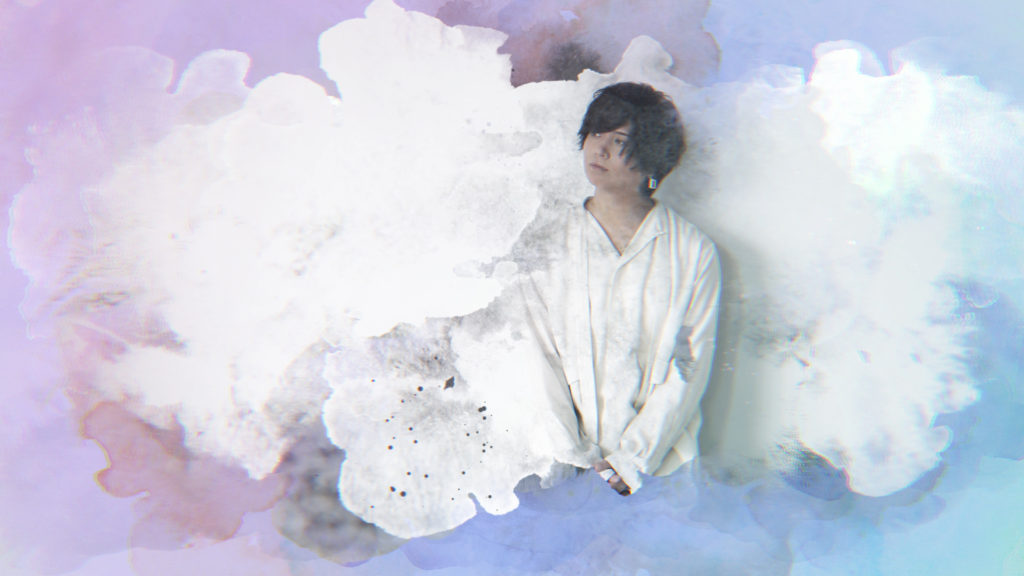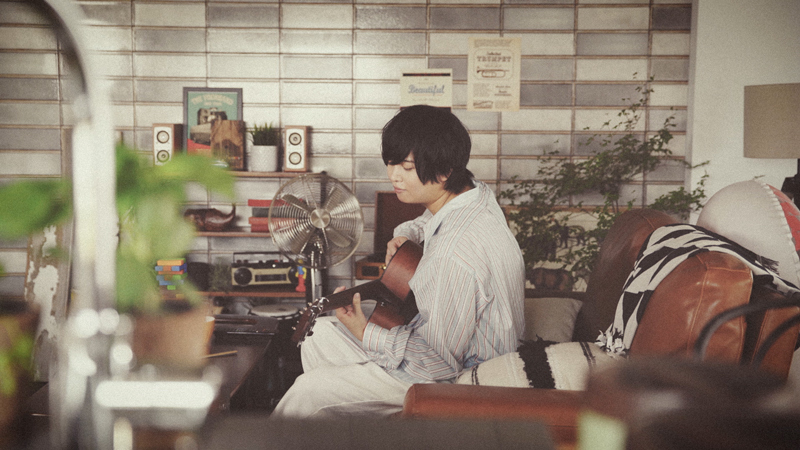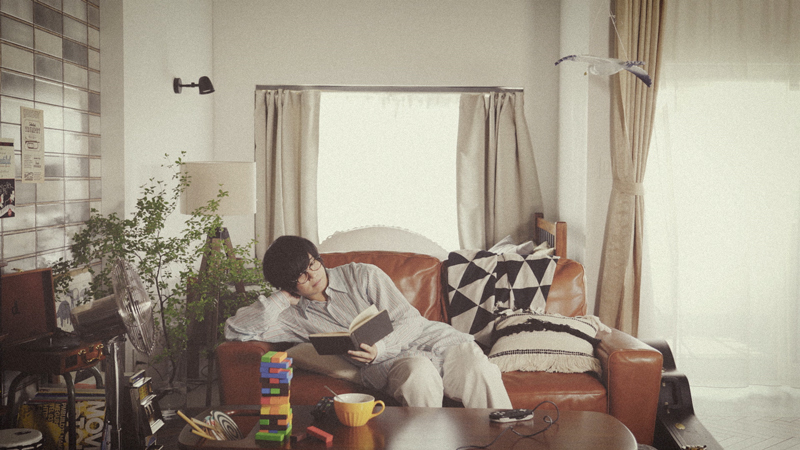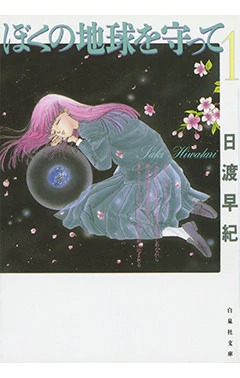Released: 2020/8/31
Soma was on the back cover and had a 16-page feature.
※There was originally a digital version released too, but it seems to be unavailable now. Either way I will not be posting scans for this one. (It’s in stock on Amazon Japan)
Interview #1: Saito Soma’s Roots and Desire for Expression
Saito has charmed many fans through his voice acting, music career, and essay-writing. Here, we explore his roots and creative side.
(1) Voice Acting
Acting is all about how close you can get to that person.
Saito Soma has appeared in many popular series such as IDOLiSH7 (as Kujo Tenn), Hypnosis Mic -Division Rap Battle- (as Yumeno Gentaro), and Haikyuu!! (as Yamaguchi Tadashi). He’s received high praise from anime fans for his diverse yet detailed acting ability. Now that he’s reached the tenth year of his career, we asked him about his stance towards voice acting, his ideal image of a voice actor, and his unique theory.
There are a lot of interesting things about this job. First is the question of “How close can I get to a character that isn’t me?” This applies to all types of acting, not just in anime—acting is all about how close you can get to that person. However, different actors have completely different ways of approaching their characters. Some people link themselves to the character while they act, while others use data to construct the character logically. Even if the approach differs, what’s most important is how well you can synchronize with the character and the project.
I myself go through a lot of trial and error, but if you ask me for my ideal, I think it’s best to be able to act without thinking about anything. In real life, you wouldn’t think, “This is my personality, so this is how I should talk,” right? It’s important to use a logical approach at first, but I want to be able to jump from there to “unconscious” acting. Right now I’m having the most fun pursuing that.
As I gained experience, my perception of time changed. The other day, I was talking to a veteran voice actor and agreed with them that it’s very important how you perceive the duration of “one second.” In everyday life, a second passes before you know it—but when we’re recording and the line is one second too short, they’ll throw in another three words, meaning that it was quite a bit too short *laughs*. This job requires us to have a macro bird’s-eye view of the overall work, and at the same time, a micro awareness of “How do I perceive one second?”
This year, it’ll have been ten years since I debuted as a voice actor, but if you asked me ten years ago, “What do you think one second is?”, I don’t think I would’ve been able to give much of an answer. I think that being able to sense an expansive space in the duration of “one second” now is a sign that I’ve grown at least a bit. The more I continue down the road of anime, the more things I notice, and the more I find myself thinking, “This part is too short.” Voice acting really is a job where you can take pride in your technique. I hope to treasure each and every one of my roles while progressing towards my goal.
But if you ask me whether or not I’m suited for this job, I still don’t know the answer. Of course, I leaped into this world because I admired voice acting, but that doesn’t mean I analyzed myself and thought, “I have these traits and weapons in my arsenal, so I can put up a fight here.” After having the opportunity to be part of so many anime series, I do have my own methodology, but as I said before, it’s not good to be too caught up in analyses and theories. Even if you stick to your ways and use what you’ve learned that way, it’s of no use if it doesn’t match the project.
You need the adaptability to let go of your fixations.
Saito has gained a wide range of expressiveness through the many characters he’s voiced. He’s built up his own voice acting techniques and methods, but sometimes it’s important to discard them.
This is veering into philosophy, but I recently came across the word “non-self” in a book I read, and I thought it was really good. Not “selflessness,” but “non-self.” It’s important to have your own “self,” as in something that forms your axis, but if you adhere too closely to it, you’ll suddenly get left behind by the world which is always in a state of flux. For example, let’s say you get assigned to a character that’s difficult to portray. You read the script and come up with your own interpretation of what kind of person they are. But if you go to the recording and they tell you “That’s not right,” how do you react? Of course, it’s fine if you just think, “Oh, so I was wrong.” But if you don’t have that flexibility and instead think, “That can’t be true!”, then you’ll get bogged down. Everyone has their fixations, but you need the adaptability to let go of them when the time calls for it. When I see my seniors doing that, I think they’re amazing.
It’s a matter of calmly looking at the work as a whole and maintaining a balance—sometimes I do it my way and sometimes I express what I sense around me. So when interviewers ask me, “What is voice acting?”, I can only say, “Right now it’s like this.” I want to be able to enjoy all of the changes.
Voice actors actually have a lot of freedom thanks to the nature of animation. For example, when it comes to gasping, there are subtle differences depending on whether it’s from a sudden realization, surprise, or shock, making for countless ways to do it. Since we’re free from the restrictions of 3-D, more detail is expected from us. I think that’s one of the characteristics of anime.
Even in a live play, I think the principles are the same as voice acting. You have a script and you connect your heart’s movements with your body’s movements… I don’t have experience with acting in traditional plays, but I think the essence is the same: getting as close to a character in a fictional world as you can. Of course, due to the medium, the way you express yourself is different—a live play has the advantage of being able to use your body—so I’m personally really interested in it. I’m turning thirty next year, and I want to challenge new things.
My favourite movies? When I was a student, I watched more indie films than Hollywood blockbusters. I was interested in surrealism because of Nakajima Ramo, so I’d watch things like Un Chien Andalou. I also like sci-fi, so I watched everything from esoteric films like Donnie Darko to staples like A Clockwork Orange. After starting this line of work, I also began watching dubs of action and comedy films. I think that translation is amazing, and it’s educational from a voice acting perspective too.
(2) Music
I was seeking something different from everyone else.
Saito’s artist career began in 2017 with the single “Fish Story.” In 2018, he showed off his talent for composition, lyrics, and even CD cover design with his first album “quantum stranger.” His style combined his deep musical sense with “the voice actor Saito Soma’s” pop music. Now, he’s evolving that style even further. First, let’s take a look at his musical journey.
Rather than listening to music from specific periods or listening in a systematic way, it feels more like I reach out to whatever I like or am interested in. In elementary school, it was centered around what my parents listened to in the car: Yuming-san (Matsutoya Yumi), Inoue Yosui-san, Spitz. They also played a lot of the Beatles. I still like those songs, and I think they’re reflected in the music I write now.
I fully got into music in my first year of middle school because of a friend I made. His whole family was into subculture—his parents and older brother were all knowledgeable about pop culture and subcultures. He put his recommended songs on a MiniDisc for me, and on it was U2; “Jumpin’ Jack Flash” by the Rolling Stones; Emerson, Lake & Palmer; Marilyn Manson; and Kinniku Shoujo-tai. Those varying genres of bands were my gateway, and I delved deeper from there. As for the current music at the time, my middle school years happened to coincide with the rock ‘n’ roll revival period. Some of the bands I liked were the Stripes, the Libertines, and Bloc Party. I listened to their songs a lot.
Looking back now, I think I was seeking something different from everyone else. It wasn’t that I was trying to reach farther, but rather, I proactively took in things that other people didn’t know about and weren’t interested in. I was looking for “someone who isn’t me, in a place that isn’t here.” I think it was music and fictional works such as novels, movies, and animation that satisfied that longing of mine.
I think I realized that it was important to absorb different things, contemplate them by myself, and decide what to do.
In elementary school, I was aware that I was living as a model student. As a child, I lived my life thinking about how I should act to get adults to accept me… So when I learned about rock, punk, and literature, I think I was shocked to discover that those things existed in the world. They were vulgar in a good way, and very free. They made me think that maybe I’d been living my life not thinking about anything. I didn’t rebel against my actual lifestyle, but I wrote songs and prose, trying to become a me who wasn’t a model student. I think I realized that it was important to absorb different things, contemplate them by myself, and decide what to do.
I prioritize entertainment value above all else.
Considering that he’s been delving deep into music ever since middle school, it was inevitable that he’d start his own artist career. Just like with voice acting, he has his own unique stance when it comes to music too. His central principle is entertainment value that a wide variety of listeners can enjoy.
When it comes to the music career of “the voice actor Saito Soma,” I prioritize entertainment value above all else. My voice acting work came first, and the various connections I made through there gave me the opportunity to release songs and perform live. But I don’t exactly try to show my true colours there in a “listen to what I have to say” way. In all of the songs I’ve released so far, there hasn’t been a single message song or love song. I’d say I’m more similar to Pete Doherty (from the Libertines) who also often wrote lyrics about fictional settings. Although as a listener, I do enjoy message songs too, and there are love songs that tug at my heartstrings.
Also, rather than songs that say “You’re not alone,” I’m more drawn to songs that say “It’s okay to be alone.” Like Elliott Smith’s lyrics, or in terms of Japanese bands, ART-SCHOOL, BURGER NUDS, GRAPEVINE…that kind of introspective mood. I want to mix that element into the voice actor Saito Soma’s pop music.
My songs don’t have any of that “Happy! Yay!” stuff in them, so they might not be suited for live concerts *laughs*. I was in a band when I was a teenager, but at that time, I was already thinking, “I want to create the best music” instead of “I want to perform live.” That hasn’t changed, so when I’m composing, I don’t think about whether I’ll be able to reproduce the songs at a concert. For example, “Waltz” and “Lemming, Ai, Obelisk” have a ton of layered vocals. It becomes a question of “How are you going to perform this live?” *laughs*
I also like albums that have concepts, and I’m fussy about CD jacket designs too. CDs are more than just music—you can put them on display and the lyrics cards are fun to read. I suspect that we’ll be the last generation to experience the appeal of CDs, so I want to provide the enjoyment of holding music in a physical form. For the packaging, I work together with the record label’s producer and designer. While I do present my own design direction, the staff also suggest a lot of ideas that I think are great. I love how it feels like we’re creating it as a team, and it’s a lot of fun.
(3) Writing
I don’t include any personal messages in my writing at all.
Saito Soma is also known as a writer. In 2018 he released his first essay collection, Kenkou de Bunkateki na Saitei Gendo no Seikatsu, and he actively does writing work. We asked him about his history as a reader and how he feels about writing.
Writing was my first interest, not acting or music. Everyone in my family was a different type of reader, so our house had lots of books and I naturally ended up reading from a lot of genres. My tastes were probably closest to my grandmother. Her bookshelf had the first edition of Kojima Nobuo-san’s Zankou, and it was just amazing. In middle school, I liked reading Dazai Osamu-san, Oken-san (Otsuki Kenji), and Tsutsui Yasutaka-san, among others. I also liked South American literature like Borges and García Márquez.
I wrote as a hobby in university, and after working as a voice actor, I received an offer to write an essay serialization. The serialization was published as a book in 2018, and circumstances permitting, I’d like to release a second one.
I consider essays a form of entertainment too, so I hope the readers have fun reading them. If I were to write fiction, I’d like to write a curious and bizarre story.
One time, the editor in charge of my essay collection read me a short story. It was about someone who regularly drank in Kichijoji, and at some point he accidentally wandered into an ogres’ feast, where he was made to gamble by guessing which of nine fingers was a human finger and licking it. I’d like to turn that kind of thing into an entertaining pop story, but I haven’t been able to find the time… I hope to be able to plug away at it.
Just like with my music, I don’t include any personal messages in my writing at all. I don’t think there’s any connection whatsoever between my creative works and my own thoughts and beliefs. I think that’s probably because…creating is a hobby for me. I’m not doing it with the intent of expressing my feelings… For example, I might walk outside and think, “It sure is bright,” and when the wind blows, “This feels nice.” Even if I directly convert those situations into my creations, I don’t add my own emotions to them. If there was something I really wanted to assert, I think it’d be better to say it straight out instead of going through a creative work.
Column: Tell us your recommended autumn entertainment!
First is Dazai Osamu’s “A, Aki” which can be read on Aozora Bunko. It’s about a professional poet who keeps notes on poetry materials because “you never know what kind of request will come in.” When they flip to the page for “autumn,” what’s written there is “Dragonfly. Transparent.” It shows how genius Dazai was.
Also, though the genre is horror, Tsunekawa Kotaro’s Aki no Rougoku (Autumn Prison) has a peculiar setting but is very easy to read. I often say that I like bizarre stories, and I recommend this to people who wonder what I mean by that.
As for anime, Zettai Shounen. For me, autumn is the season for sci-fi, and this anime does a great job at blending slice of life and sci-fi elements. I own the DVD boxset and have watched it many times. *laughs*
Interview #2: Saito Soma’s Artist Career – Chapter 2
The second chapter of Saito’s artist career has begun with the “in bloom” series (three digital releases) themed around “the changing of seasons” and “what comes after the end of the world.” We asked about his preferences when it comes to lyrics and producing his own music.
I feel that I can be bolder now.
Saito Soma completed Chapter 1 of his music career with his first album quantum stranger (2018) and his mini-album my blue vacation (2019). The “in bloom” series that marks the start of Chapter 2 consists of three songs: “Petrichor,” “Summerholic!”, and “Palette,” which are themed around “the changing of seasons” and “what comes after the end of the world.” Entering this new phase, he said he thought that he could be bolder music-wise. In this interview, he reflects on his career so far and speaks about where he currently stands as an artist.
My personal music career began with my debut single Fish Story, which Oishi Masayoshi-san wrote for me. Then came my second single which was centered around “the end of the world” (Yoake wa Mada / Hikari Tatsu Ame), my third single Date which I composed and wrote lyrics for by myself, my first album quantum stranger, and then my first live concert (quantum stranger(s)). With that, I felt that I’d reached a milestone. I hadn’t done everything yet, but the two years since my debut had flowed very nicely, so I thought that I could call that “Chapter 1.” The final part of that chapter was a song called “Epilogue” that was released in March this year.
Up until now, I strongly felt that “as long as I’m a voice actor, I want to produce music that has entertainment value.” That still hasn’t changed, but when I heard what my listeners had to say, I also felt that I could be bolder now. There were things that I’d originally decided not to do, but in the EP I released last year (my blue vacation), there was a song with a darker atmosphere than anything I’d released before. I’m also trying new things with “in bloom” which will be the start of Chapter 2.
As for the title “in bloom” itself… at first, I didn’t plan on giving it a name. But the producer at the record label told me to give it one because it’d be easier to promote it that way *laughs*. “in bloom” was originally going to be a song title. To put it simply, it means “after the rain, flowers bloom”—it relates to the theme of “after the end of the world.” Dazai Osamu wrote a story called Roman Dourou. It’s about five siblings that like books, and there’s a part that goes, “It says that everyone lived happily ever after, but what we want to know is what actually happened after that, right?” and I thought, “True!” I wanted to depict what happens after my “end of the world,” and that was going to be the song called “in bloom.” After the rain, beautiful flowers bloom. It also has the imagery of changing seasons.
Saito Soma’s second chapter is starting with the three songs in the “in bloom” series: Petrichor, Summerholic!, and Palette. From the lyrics to the sound production to the vocals, every song is packed with new expressions.
“Petrichor” is a shuffle beat song. The rhythm has a swing to it, and when you first listen to it, it sounds like a normal pop song—but when you look at it from a different angle, you see that it’s more than what it seems. In that sense, I think it’s a bold song. As for the lyrics, technique-wise, at first I wanted to write it without a single foreign loanword. I wanted it to feel like the “new music” genre from the 70s and 80s. But as I was writing, I thought, “There isn’t much point in imposing this restriction by myself” *laughs*. The tentative title back then was “Amadare” (raindrops dripping from eaves/etc), which led me to “Petrichor.” Petrichor is the earthy scent produced when rain falls on soil. I chose it because it’s a song themed around rain.
“Summerholic!” seems like it’ll be exciting at a concert, I think? It’s an up-tempo song with a cheerful melody. Although the lyrics are about spending summer cooped up in your room *laughs*. I put a lot of homages into this song. Specifically, the Libertines, the Cribs, and Ojamajo Doremi. The chord progression is commonly used by English rock bands, so it has a UK rock aesthetic. The melody has a summery atmosphere. The lyrics are about not going outside to play, instead eating ice cream and drinking beer in an air-conditioned room. Even though it’s bright and sunny outside, the protagonist chooses to enjoy spending their time at home.
“Petrichor” is about the rainy season, “Summerholic!” is about summer, and the third song “Palette” is about the transition from summer to fall. It tends to be a sentimental time of year, but instead of giving it a name, I decided to try turning it into a song. The lyrics are quite optimistic. At first I wanted to make them darker, but my mind changed bit by bit as I was writing. Before you realize it, summer is gone and the season has changed—and I don’t think that’s a bad thing at all. I was rewriting the lyrics up until the day of the recording, and it became a song that expresses painful feelings within grandiose sound. I want “Palette” to be heard in the loudest volume that your environment will allow for. I think it’s an immersive song, so you can even pretend you’re the MV’s protagonist when you listen to it. *laughs*
For all three songs, we were joined by amazing musicians. “Petrichor” was done quite experimentally, while I could really feel the band’s groove in “Summerholic!” and “Palette.” Ono Takemasa-san’s (from KEYTALK) guitar solos greatly exceeded the scope of the demos. That’s the thrill of creating music as a team, and I’m thankful for it.
As for the sound, I consciously produced the songs in the style of Western music. By not increasing the number of notes, it creates gaps where you can feel the groove. I also emphasized listenability, but they did end up being quite bold. Also, I obtained quite a lot of equipment during the stay-home period. I used to create my demo tracks by recording myself singing to my own guitar, but now I can do some of the programming myself too. I want to combine the best aspects of analog and digital.
Due to the COVID-19 pandemic, there are restrictions on all artist concerts. Saito is no exception, but he seems to have an idea of what kind of live performance he can do.
Live concerts aren’t possible in the current situation, but there’s nothing that can be done about that. If the situation improves, I’d like to try an acoustic concert. My songs aren’t the kind where everyone gets loud and hyped up anyway *laughs*. I think it’d be nice to have people listen to them carefully in acoustic form. Dirty Pretty Things’ first album Waterloo to Anywhere had an acoustic version of one of the songs as a bonus track ((note: Japanese edition only)), and I suspect that it was recorded in a big area, which sounds really fun. I think it’d be nice to have a fun acoustic concert with the musicians for everyone to see. It’s only a thought, though—nothing’s been decided yet.
I’m actually not that comfortable with my own concerts. When I’m standing in front of people as Saito Soma, rather than a character, I don’t know how I should act. But I gain very much from it. Brainstorming with all of the staff, spending time to prepare, and then putting on the show itself—the sense of accomplishment after making it through isn’t something that you can feel just anywhere. Year by year, the joy of concerts is budding within me.
Staff Interview: Saku
Saku is a composer, lyricist, arranger, and guitarist who has been deeply involved with Saito’s music. We asked him about Saito’s songs, lyrics, and nature.
It’s my role to organize Soma-kun’s ideas and brush them up.
Saku has been the main arranger supporting Saito Soma’s music from his third single “Date” up until now with the “in bloom” series. He’s also done composing and guitar work for artists like Kanjani∞, Aoi Eir, Haruna Luna, Amamiya Sora, and Kito Akari. We asked him about how he met Saito, as well as the nature of Saito’s music and character.
I met Soma-kun in 2018 when the record label producer introduced us to each other. I joined them when they were drinking and we talked about various things. We hit it off right away because of our similar tastes, like how we both liked GRAPEVINE. He showed me the song “Reminiscence” that later became part of his third single Date. It had a bit of a GRAPEVINE feel to it, and after listening to it once, I really liked it. From there, I got to be the arranger for his songs. It was right when he started doing his own compositions and lyrics.
Soma-kun’s songs are a bit unusual. The chord progressions and melodies have unexpected parts that make you think, “It’s going that way?”—anyway, they’re unique. For example, “Summerholic!” has parts where the chords and melody don’t match up, but when you try to change the chords to the right ones, something feels wrong. That’s Soma-kun’s characteristic quirk. Building up his songs as an arranger is extremely stimulating, and I’ve gained a lot from the experience.
His lyrics also have a unique world view. Every time he sends me a song, I look up word definitions *laughs*. I understand the content, but I’d never be able to write these lyrics myself.
It seems that at first he used his iPhone to record himself singing to his guitar, but lately he’s been able to do his own programming and the quality of his demos has greatly improved. He also sends me reference tracks, saying things like, “I want the rhythm to be like this song” and “the guitar should sound like this song,” and they’ll be songs that only an enthusiast would know. The noise guitar reference for “Petrichor” was an artist named Arto Lindsay, and I didn’t know who that was *laughs*. Soma-kun really is knowledgeable about a lot of different music.
We’re trying new things with the “in bloom” series. The saxophone phrase in the intro to “Petrichor” was Soma-kun’s idea. In the demo he played it with guitar and asked to use a saxophone for it. It’s my role to organize Soma-kun’s ideas and brush them up.
He’s also an amazing vocalist. He has the strength you’d expect from a male vocalist, but his high notes also feel like a woman’s vocals. He also has a clean falsetto, so we often layer the chorus melody with one an octave higher. Soma-kun seems to like doing that too. When we’re recording, he doesn’t just sing the way that was planned—he also gives suggestions, like, “How about this way?” It’s really fun to make changes on the spot like that.
Soma-kun’s human nature? How do I put this… He’s really a good kid *laughs*. He’s polite to everyone, he’s friendly, and everyone loves him. It comes really naturally too. It doesn’t feel like we’re just work associates—it feels like Soma-kun, the producer, the engineer, and I are in a band together. He often sends me LINE messages like, “I hadn’t given Foo Fighters a proper listen, but they’re cool, huh?” *laughs*
I hope that Soma-kun will continue to demonstrate more of his individuality. He already has a lot of dark songs, but I think he can step into his dark side even more. But since Soma-kun’s really nice, I think he’ll also compose songs that will make his fans happy.
Bonus: Off-shots from the photo shoot (2 per tweet GIF)

